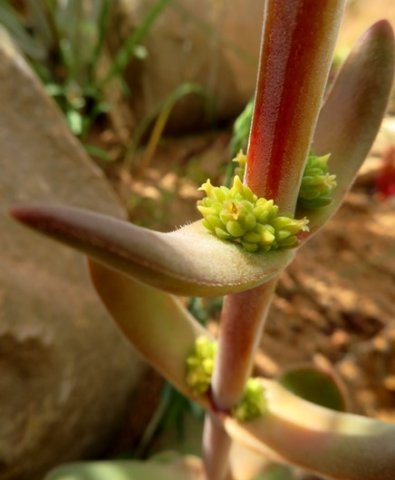Crassula nudicaulis var. platyphylla big bracts, still small inflorescences

When the Crassula nudicaulis var. platyphylla flower clusters start off from leaf axils they are stalkless and green all over. Only the developing calyces are on show. Flowerhead or cluster peduncles may, however, later become fairly long in this variety.
The opposite, up-curved, oblong bracts are leaf-like. They appear long at this stage, compared to the emerging flower clusters developing after them. The next pair of bracts on the stem grows at a right angle to the one before, a decussate arrangement of floral components. There is gloss on one stem section in picture.
Peering with open eyes and focused mind at obscure features of a living thing, albeit a corona virus under a microscope or a common weed in the garden, is a key part of human life. Minds are there for dealing with what is in the line of sight and how it becomes or behaves, whether the observer is a toddler or a scientist.
Assisting the old in loving their five window sill container plants more intensely after the cat or the parrot is dead, is done by guiding their eyes in observing details and small changes. For these things kindle the imagination, bring a life to life.
Whether the eye sees rocks on Mars during an Elon Musk initiated jaunt or the gait of an ant walking in after lonely lifer years in an Alcatraz cell, wonderment seizes the mind of the aware observer (Smith, et al, 2017; Frandsen, 2017; Manning and Goldblatt, 1997; iNaturalist).

